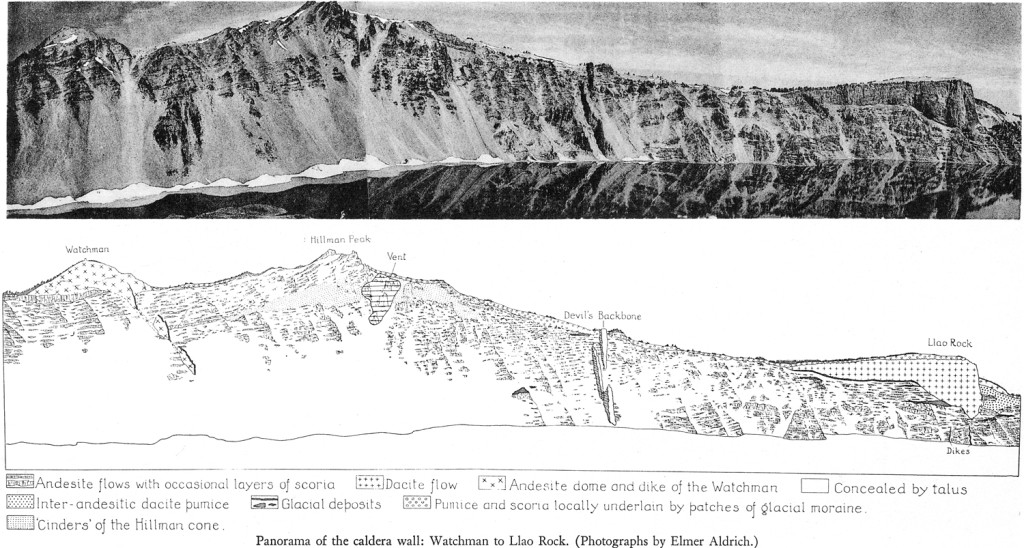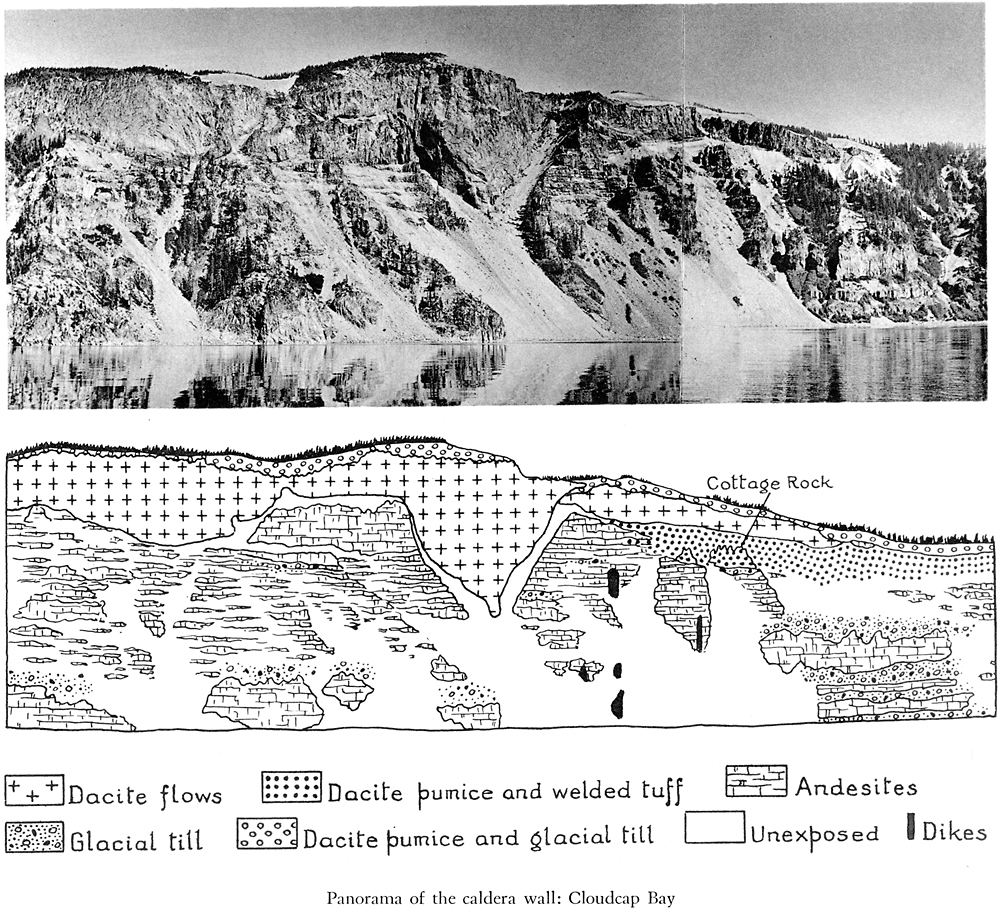The Geology of Crater Lake National Park, Oregon With a reconnaissance of the Cascade Range southward to Mount Shasta by Howell Williams
The Main Andesite Cone of Mount Mazama
Dikes
Andesite Dikes
Of all the dikes on the walls of Crater Lake, only one, the Devil’s Backbone, reaches from the water’s edge to the rim. If this once served as the feeder to a surface flow, the lava has been removed by erosion. Close to the lake the dike is 23 feet wide, but upward it increases in width to approximately 50 feet. Slightly more than halfway up the caldera wall, the dike is offset (plate 29). Like the dacite intrusions just mentioned, the Devil’s Backbone has thin glassy selvages enclosing a paler, holocrystalline, and somewhat vesicular core rich in cristobalite.
Plate 29. Panorama of the caldera wall: Watchman to Llao Rock. (Photographs by Elmer Aldrich.)
Perhaps the most interesting of all the intrusions are those on the walls overlooking Steel Bay, under the east “wing” of the Llao flow. These, as indicated already (page 34), represent feeders of surface flows.
On the cliffs overlooking Grotto Cove, a dike with glassy, vesicular borders can be traced upward from the edge of the lake through a vertical distance of approximately200 feet. Throughout this distance it maintains a width of 10 to 15 feet. Close to the top, on its western face, the margin includes a few reddened glacial boulders a foot or so in diameter.
Two conspicuous dikes cut the lavas on the walls immediately south of the great V-shaped dacite flow forming Redcloud Cliff. These are shown on the panorama, plate 23. The larger dike, which has a width varying between 6 and 8 feet and descends almost to the edge of the lake, has glassy margins, but its interior is composed of normal pilotaxitic hypersthene andesite.
Plate 23. Panorama of the caldera wall: Cloudcap Bay
About halfway between the center of Cloudcap Bay and Sentinel Point there is another conspicuous wall-like dike of andesite with glassy margins. On Sentinel Point itself, a similar dike descends to the water’s edge. At that level its width is 25 feet, but upward it breaks into two thinner branches. The margins of this dike are glassy, but the core is crystalline and vesicular and carries many basic inclusions.
Phantom Ship consists of pale-green lapilli tuffs and tuff breccias cut by two branching, more or less vertical dikes of dense, black andesite. The pyroclastic rocks are part of the old Phantom cone, and the dikes appear to be radial with respect to the central conduit exposed on the adjacent Dutton Cliff. The larger dike forms most of the northwest half of the island and is responsible for several of the sail-like pinnacles of the “ship.” Apparently the dikes were intruded after the enclosing tuffs had suffered extensive alteration, though the concentration of hematite along cracks cutting the margins of the dikes shows that the intrusions themselves suffered attack by fumarolic vapors.
Below Sun Notch there is a dike of olivine-bearing hypersthene andesite, 6 to 8 feet wide, which reaches almost to the rim of the caldera. Thirty feet from the point where it disappears beneath the talus, the dike splits into two parts, each about 5 feet wide. Both parts consist of black, glassy lava devoid of basic inclusions.
An unusually long dike cuts the Eagle Crags near Garfield Peak, descending from a point not far inside the rim to the edge of the lake, more than 1200 feet below. On account of the solfataric alterations to which this intrusion has been subjected, a fuller account is given in the section dealing with petrography (page 145)
Finally, a similar dike, trending almost east-west, is traceable throughout the greater part of the caldera wall immediately west of the trail leading to the boat landing.
***previous*** — ***next***



